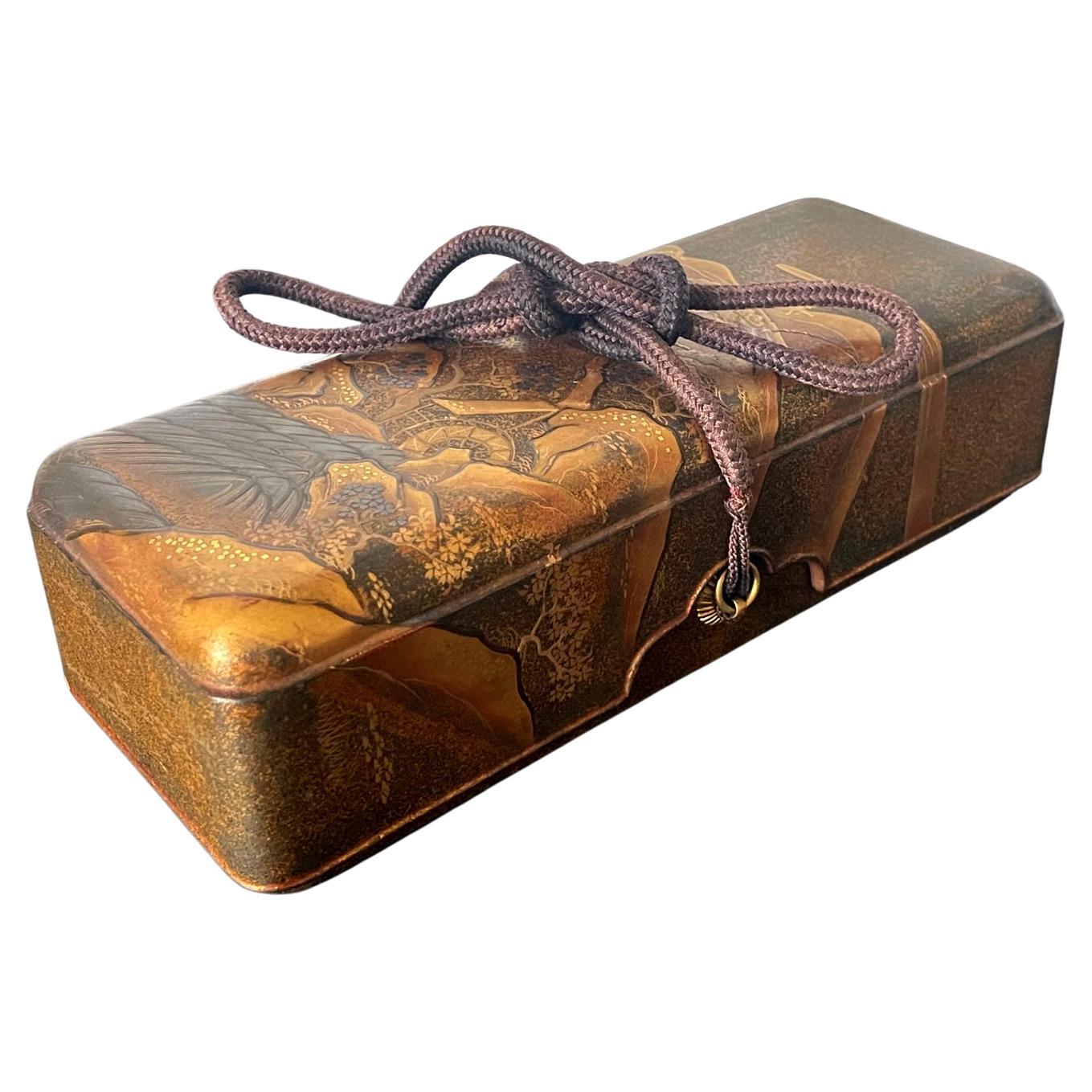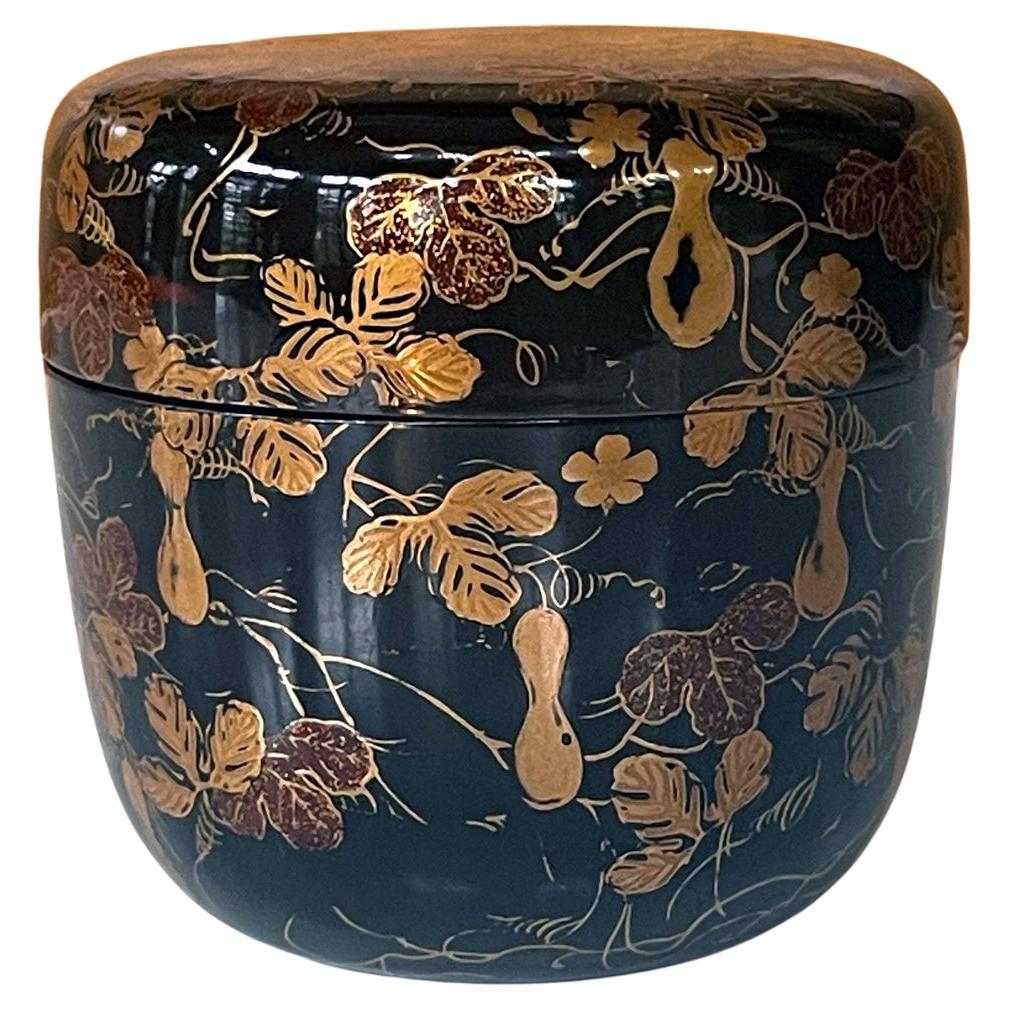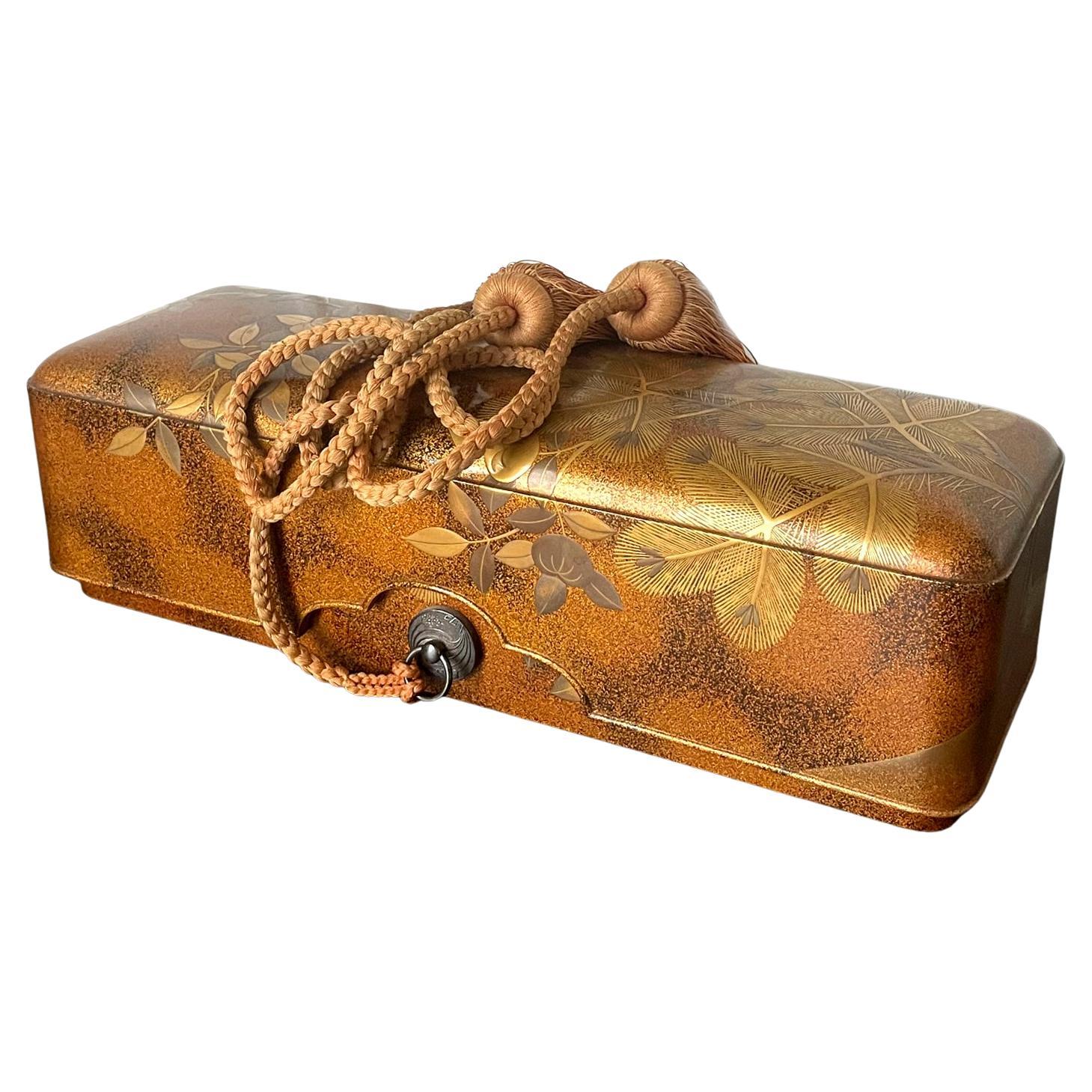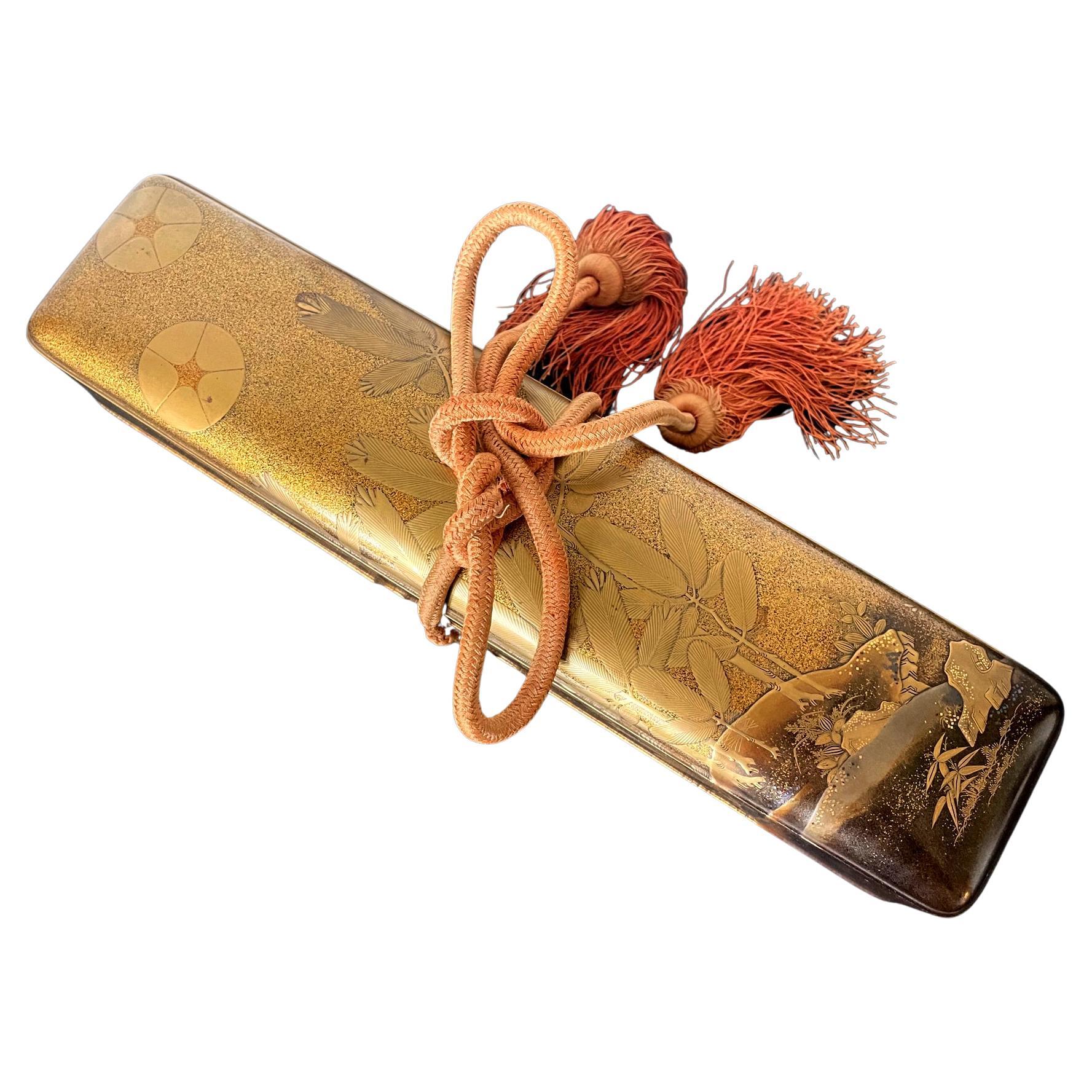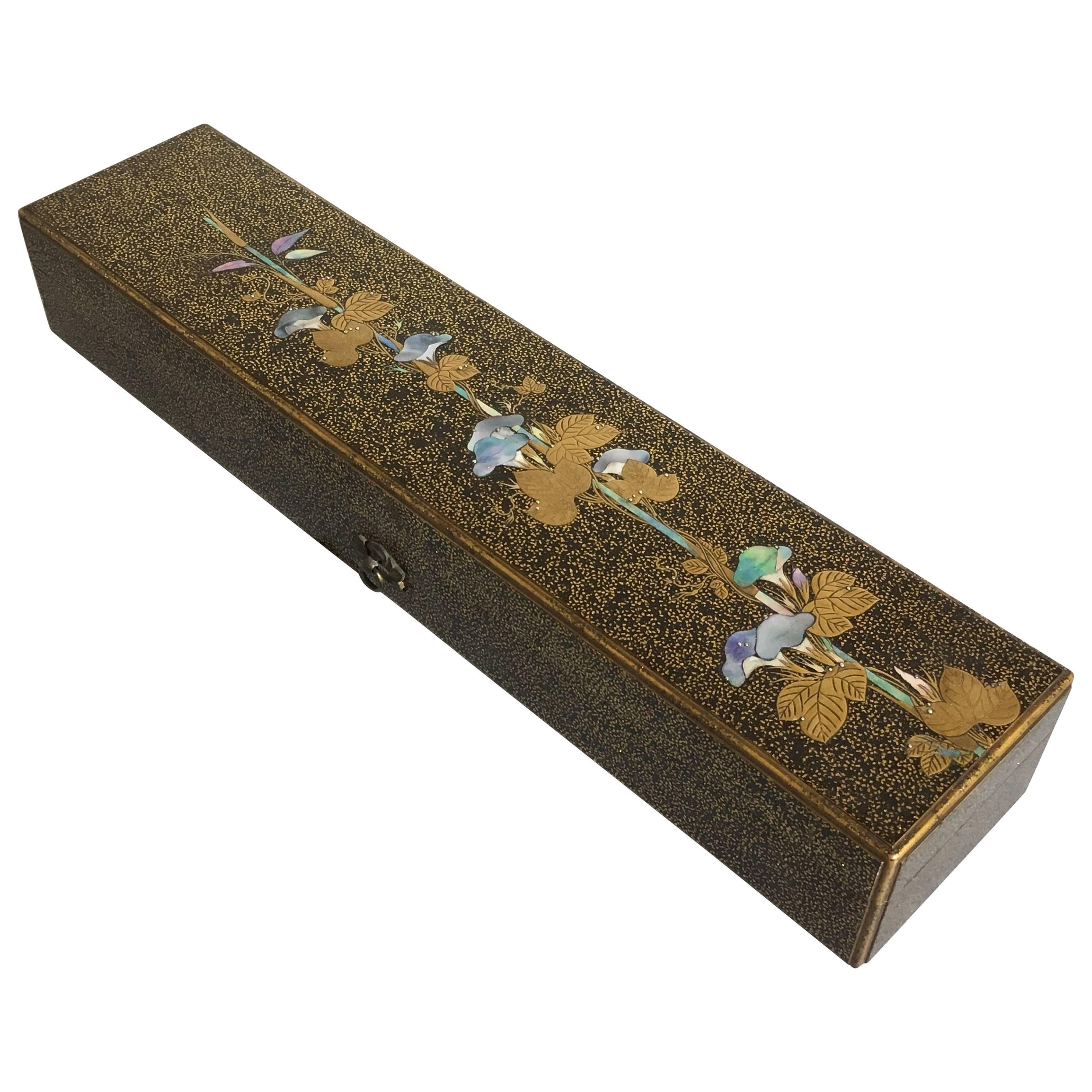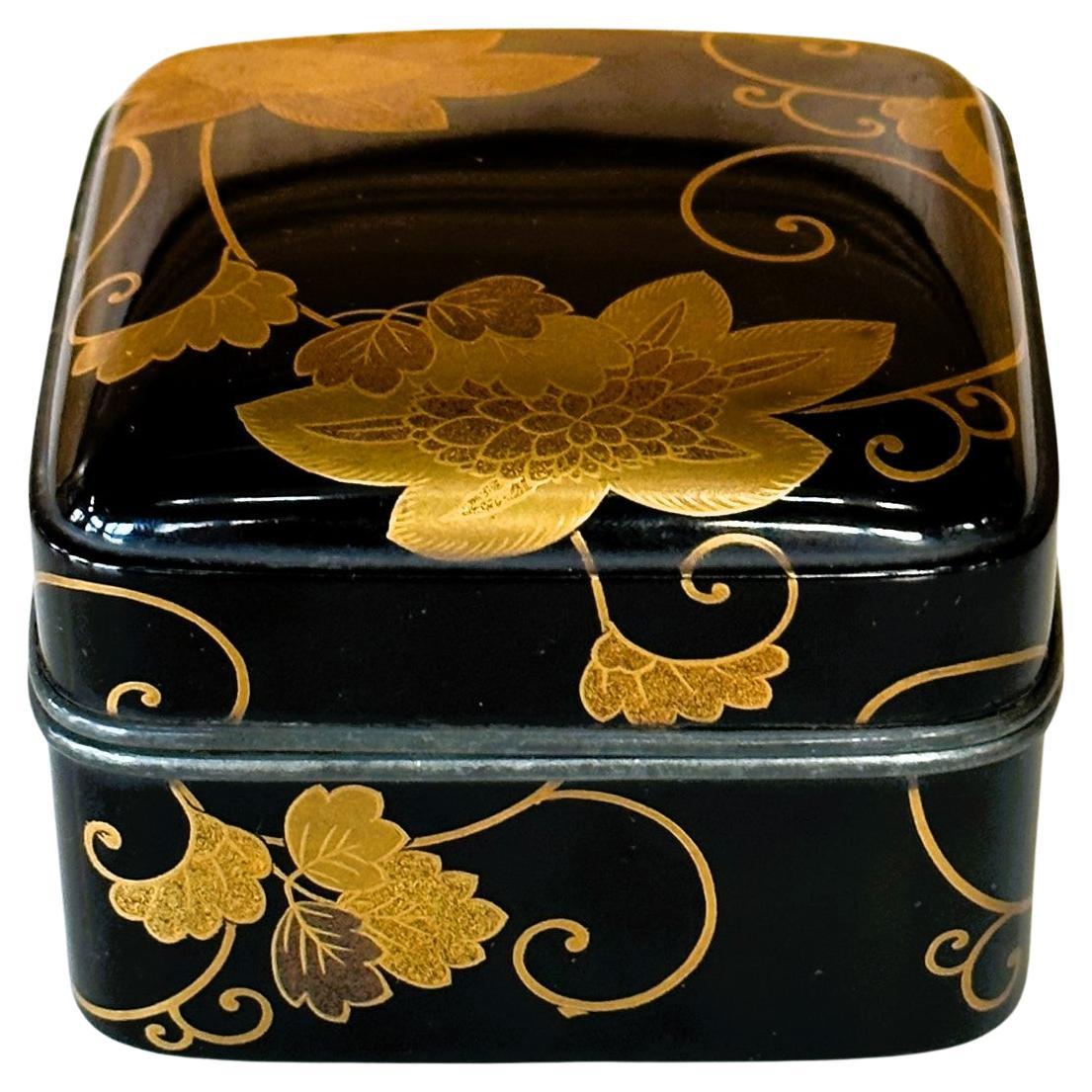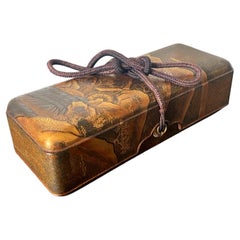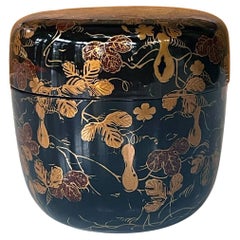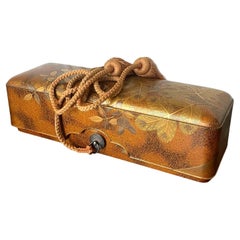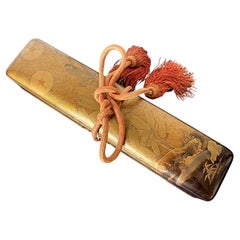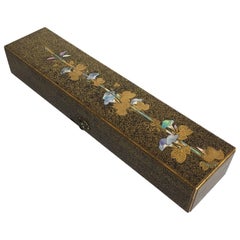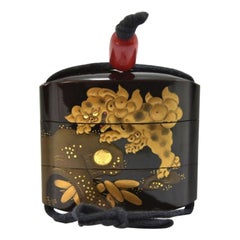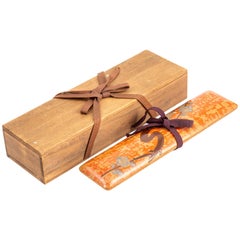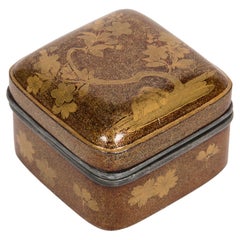Items Similar to Japanese Lacquered Maki-E Fubako in Kodaiji Style
Want more images or videos?
Request additional images or videos from the seller
1 of 20
Japanese Lacquered Maki-E Fubako in Kodaiji Style
$4,200
£3,166.82
€3,649.32
CA$5,826.54
A$6,528.60
CHF 3,398.39
MX$79,867.40
NOK 43,136.22
SEK 40,741.64
DKK 27,242.90
Shipping
Retrieving quote...The 1stDibs Promise:
Authenticity Guarantee,
Money-Back Guarantee,
24-Hour Cancellation
About the Item
A rare Japanese lacquered wood fubako decorated in Kodaiji maki-e style circa early 17th century the beginning of the Edo period, possibly early toward the end of the Azuchi-Momoyama period. The rectangular, long and slim box features a deep lipped lid with slightly rounded corners, a conforming lower box with two bronze medallion rings with tasseled silk ties. The decorative style of the surface was in a typical style called "Kodaiji style" originated in the 16th century during Momoyama period from the Kodaiji, a Zen Buddhism temple located in Kyoto. The characteristics of this style include the following: a pure black background on which various shades and thickness of shimmering gold maki-e were applied, creating a beguiling contrast. The imagined designs tend to be simple but elegant with emphasis on geometrical form, with the favorite motifs being the floral pattern of the fall. The technique used was revolutionary for the time with nashiji being used for part of the design instead of as background. This is called e-nashiji. Often there are outlines of the floral that was executed with dense gold powder. This box displays all the above features. Its black background has faded into a brown over the centuries. The Tri-Star shaped leaves with small flowers permeated the overall design. Nashiji of different shades of color and density was used to fill in the space of the leaves outlined with even denser nashiji. There are also curved lines in between representing the water, that was created in hiramaki-e (low relief maki-e). The repetitive design is rather simple, and the motif of the paired leaves continues to the side of the box and overlaps with the under covered box, which shows a much more vibrant colors due to the shield from the light. The two bronze medallions appear to be original with a design that matches the shape of the leaf. The trim was finished in dense nashiji instead of fundame. The interior and the base were left unadorned in black. There is an expected sun fading along contour of the lid. The box comes with a storage tomobako with some ink inscription underneath, but we are not sure if this is original.
This fubako shows significant age and patina. The oxidation has caused significant browning overall. Although there are no obvious losses, we do observe scattered chips and nicks and crack and wrinkle lines on the lacquer, some of which are evident in the detail photos. One end of the lid shows a noticeable crack through that was repaired.
- Dimensions:Height: 2.25 in (5.72 cm)Width: 14.5 in (36.83 cm)Depth: 2.5 in (6.35 cm)
- Style:Edo (Of the Period)
- Materials and Techniques:
- Place of Origin:
- Period:Early 17th Century
- Date of Manufacture:Early 17th Century
- Condition:Repaired: One end of the lid has a crack line which was repaired at some point of the life of the box. Wear consistent with age and use. Minor losses. Minor fading. General patina and wear, including minor chips on the rim, some bumps and nicks, some cracking and ripping of the lacquer finish, overall fading. wear on the base. Bronze rings appear original, but the silk ties are later replacement.
- Seller Location:Atlanta, GA
- Reference Number:1stDibs: LU945033178342
About the Seller
4.9
Platinum Seller
Premium sellers with a 4.7+ rating and 24-hour response times
Established in 2006
1stDibs seller since 2010
564 sales on 1stDibs
Typical response time: <1 hour
- ShippingRetrieving quote...Shipping from: Atlanta, GA
- Return Policy
Authenticity Guarantee
In the unlikely event there’s an issue with an item’s authenticity, contact us within 1 year for a full refund. DetailsMoney-Back Guarantee
If your item is not as described, is damaged in transit, or does not arrive, contact us within 7 days for a full refund. Details24-Hour Cancellation
You have a 24-hour grace period in which to reconsider your purchase, with no questions asked.Vetted Professional Sellers
Our world-class sellers must adhere to strict standards for service and quality, maintaining the integrity of our listings.Price-Match Guarantee
If you find that a seller listed the same item for a lower price elsewhere, we’ll match it.Trusted Global Delivery
Our best-in-class carrier network provides specialized shipping options worldwide, including custom delivery.More From This Seller
View AllJapanese Lacquered Maki-e Fubako Edo Period
Located in Atlanta, GA
A Japanese lacquered wood fubako (a box used to store document or small scroll painting), circa second half of 19th century late Edo period. The rectangular box features an unusually deep lipped lid with slightly rounded corners, a conforming lower box that is almost entirely covered by the lid which has two bronze medallion rings with tasseled...
Category
Antique 19th Century Japanese Edo Lacquer
Materials
Wood, Lacquer
Japanese Lacquered Maki-E Natsume in Kodaiji Style
Located in Atlanta, GA
A Japanese lacquered tea caddy (known as Natsume) with fine Maki-e decoration circa 18-19th century Edo to Meiji period. The large-sized nat...
Category
Antique 19th Century Japanese Meiji Lacquer
Materials
Wood, Lacquer
Japanese Lacquer Maki-E Scroll Box Fubako by Kansonsai Edo Period
Located in Atlanta, GA
A Japanese lacquered wood fubako (a box to store document or small scroll painting) circa late 18th century of Edo period. The rectangular box features a deep lid with rounded corners and recessed mid-edge and a lower box with two bronze medallion rings and tasseled silk ties. The surface of the fubako was elaborately decorated with hiramaki-e and a low takamaki-e on a mottled Mura-nashiji background. The motifs on the lid depict branches of Japanese pine with finely rendered needles on the lower part; on the upper part, it showcases fruited persimmon branches. Two different shades of gold fundame were used to contrast the design and augmented by scattered gold kirigane to highlight some of the leaves. The design continues and cascades down to all sides of the lid as well as the walls of the box. The two bronze medallions appear original to the box and the silk ties show significant fading from the age. This Fine fubako is signed on the lower wall "Kanshosai" in Kanji with a kao mark. All the trims were finished in gold fundame and the interiors a dense nashiji in gold.
Kanshosai is the mark of the distinguished lacquer artist Lizuka Toyo I who also signed his work "Toyosai". He was active in the second half of the 18th century during Edo period, employed by Hachisuka Shigeyoshi (1738-1801), daimyo of Awa on Shikoku Island. Although most survived work bearing his marks are inros, he was also known to decorated trays and other larger objects...
Category
Antique Late 18th Century Japanese Edo Lacquer
Materials
Wood, Lacquer
Japanese Lacquered Gold Maki-E Naga Fubako Meiji Period
Located in Atlanta, GA
A Japanese lacquered wood Naga Fubako (a long box used to store document or large scroll painting), circa 19th century Meiji period. The rectangular box features an unusually deep lipped lid with slightly rounded corners, a conforming lower box with bronze medallion rings with tasseled...
Category
Antique 19th Century Japanese Meiji Lacquer
Materials
Wood, Lacquer
Antique Japanese Lacquered Incense Box Kobako in Kodaiji Style
Located in Atlanta, GA
An antique lacquered small box that was likely used to contain incense powder (it is called Kobako in Japanese), circa early to mid-19th century of the Edo...
Category
Antique 19th Century Japanese Edo Lacquer
Materials
Wood, Lacquer
Exquisite Japanese Lacquer Maki-e Hand Box Kobako Edo Period
Located in Atlanta, GA
An early Japanese lacquer Maki-e decorated kobako (small storage box) circa 18th century (Edo period). Based on its form and size, this kobako was possibly used as a Chabako to store the accoutrements for chado (tea ceremony). The lidded box is of rectangular form with bevel design on all edge that softens the appearance. The entire surface was densely covered with a background of nashiji. Elaborate Maki-e techniques were used on each side to showcase a distinct landscape or floral design within a cartouche panel. On the surface of the lid, a mountainous landscape rises from the edge of the water. The poetic composition is akin to a traditional ink scroll...
Category
Antique 18th Century Japanese Edo Lacquer
Materials
Lacquer
You May Also Like
Japanese Edo Period Igarashi School Long Lacquer Box, Tanzaku-Bako
Located in Austin, TX
A stunning Japanese Edo period lacquer tanzakubako, box for poem cards, late 18th-early 19th century, Edo Period, Japan.
Attributed to the Igarashi School, this box is masterfully ...
Category
Antique Early 19th Century Japanese Edo Lacquer
Materials
Mother-of-Pearl, Lacquer
Japanese Inro XIXth Century with 3 Lacquered Wood Boxes
Located in Marseille, FR
19th Century Japanese inro with 3 lacquered wooden compartments, 63 x 70 x 22 mm in size. Weight 39.1 g.
Additional information:
Material: Lacquered ...
Category
Antique 19th Century Japanese Snuff Boxes and Tobacco Boxes
Materials
Wood
Vintage Japanese Wakasa Lacquer Folder for Poems and Paintings
Located in Prahran, Victoria
A Japanese Wakasa lacquer folder to carry poems and paintings. It has a silver raised Togidashi maki-e design of cherry blossom, created by lay...
Category
Vintage 1960s Japanese Lacquer
Materials
Silk, Wood
Japanese lacquered Cherry Tree Kobako
Located in PARIS, FR
Kobako in nashiji lacquer of square shape with a hira maki-e décor of a blossoming
cherry tree. Both of the four sides are adorned with golden lacquer cherry flowers,
represented i...
Category
Antique 19th Century Japanese Lacquer
Materials
Lacquer
Japanese Lacquer Writing Box, Suzuribako, Edo Period, 18th Century, Japan
Located in Austin, TX
An exceptionally fine and unusual Japanese lacquer writing implements box, suzuribako, in the form of a zither, koto, Edo Period, 18th century, Japan. With a modern wood storage box,...
Category
Antique 18th Century Japanese Edo Lacquer
Materials
Gold, Silver, Copper
Japanese inro of the edo period adorned with a landscape houses near a lake
Located in PARIS, FR
Inrō with four gold lacquer compartments, decorated with a lake landscape. Accompanied by a bronze ryusa manju.
Small boxes formed of compartments that fit one on top of the other, i...
Category
Antique Late 18th Century Japanese Edo Lacquer
Materials
Gold
More Ways To Browse
Black Gold Lacquer
Black Lacquer Storage
Bronze Medallion
Antique Bronze Medallions
Black Lacquer Gold Leaf
Black Bronze Japanese
Japanese Zen Furniture
Medallion Ring
16th Century Japanese
Japanese Wood Temple
Temple Lacquer
Antique Japanese Rings
Japanese Gold Lacquer Box
Antique Round Wood Box
17th Century Wood Box
Antique Powder Boxes
Maki E
17th Century Gold Ring
